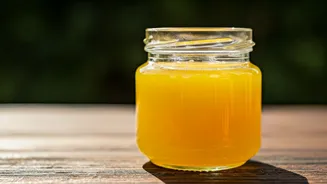The Ghee Challenge
Ghee, a staple in many Indian households, faces a significant problem: adulteration. This practice involves mixing pure ghee with cheaper substitutes,
often without consumers' knowledge. This not only cheats consumers financially but also raises health concerns. The adulterants used can be harmful, impacting the nutritional value and potentially causing adverse health effects. Therefore, recognizing and avoiding adulterated ghee is crucial. It ensures that individuals consume a product that aligns with their expectations and maintains their health and well-being. This requires awareness and practical methods to assess the ghee's purity at home, which this article addresses.
Visual Inspection Matters
One of the initial steps to evaluate ghee involves a visual check. Authentic ghee typically exhibits a clear, golden-yellow color. Its appearance is a strong indicator of its purity. When in a solid state, high-quality ghee should present a granular texture. These granules arise from the specific fat composition and processing methods used to create authentic ghee. Any variations from this color and texture, like a pale, uniform appearance, could be a red flag. These anomalies may suggest the presence of additives or substitutes. Examining the visual aspects serves as an easy and accessible way to screen for potential adulteration, acting as a first line of defense for consumers.
Heat Test Explained
A basic, yet effective test to assess ghee's purity involves a simple heating process. Take a small amount of ghee in a pan and heat it gently. Pure ghee will melt quickly and turn transparent. It should also release a rich, nutty aroma. If the ghee does not melt quickly, or if it has a dark or uneven color change, it might be adulterated. The smell also plays a crucial role; if the scent is artificial or lacks the characteristic ghee fragrance, it's another indicator of possible impurities. This method is easily performed at home and offers immediate feedback. It provides a quick way to discern the quality of ghee, alerting consumers to potential problems.
The Cooling Test
This test involves melting a small amount of ghee and letting it cool at room temperature. Genuine ghee solidifies into a uniform, granular texture, mirroring the characteristics seen at room temperature. If the ghee doesn't solidify with this characteristic texture, or if it forms separate layers or an uneven appearance, this raises suspicion. This behavior might suggest that other oils or fats are blended into the ghee. These oils solidify differently and often create the observed variations in texture. The cooling test is easy to perform and offers a further layer of verification, helping consumers confirm the authenticity of their ghee. It works well along with the visual and heating tests.
Taste and Aroma
The sensory evaluation is also very important, especially taste and smell. Authentic ghee delivers a distinct, nutty, and slightly sweet flavor. Its aroma is rich and inviting. If the ghee tastes bland or has an odd flavor, it's likely adulterated. The presence of metallic or chemical aftertastes is a strong indicator of impure ghee. Similarly, the scent should be inviting and characteristic of fresh ghee. Any off-putting smells, such as rancidity or artificial scents, are clear signals. Tasting and smelling the ghee directly provide a reliable method to sense any impurities. This sensory evaluation method reinforces the need to scrutinize the ghee carefully for quality.
The Iodine Test
The iodine test provides a more scientific approach to detecting adulteration, specifically the presence of vegetable oils. To perform this, a small amount of ghee is mixed with a few drops of iodine solution. If the mixture turns blue, it suggests that vegetable oils are present. These oils react with iodine to create this color change. Pure ghee will not change color significantly. While it requires the availability of an iodine solution, this test delivers a more precise indication of adulteration. It provides a means to assess the presence of specific additives that might be missed by the simpler tests. The iodine test is useful for consumers aiming to make sure their ghee is pure.
Choose Reputable Sources
Besides testing methods, selecting ghee from trusted sources is essential. Buying from established brands or reputable local dairies significantly reduces the risk of encountering adulterated products. These sources typically have strict quality control measures. Always check for certifications like FSSAI (Food Safety and Standards Authority of India) which provides assurance of the product's safety. Examine the packaging for detailed information about the ingredients, manufacturing processes, and certifications. This information acts as a key for product evaluation. Careful selection and source verification helps ensure consumers can purchase authentic and safe ghee. Trusting reliable sources is a very proactive step.














